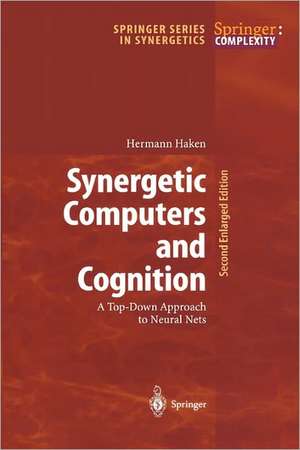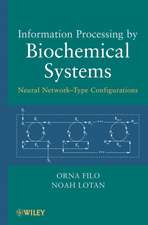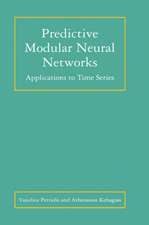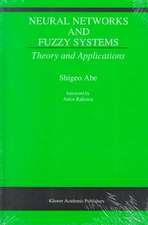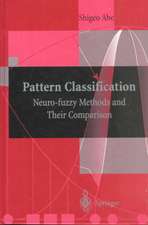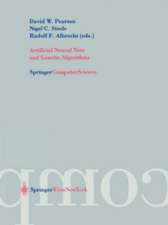Synergetic Computers and Cognition: A Top-Down Approach to Neural Nets: Springer Series in Synergetics, cartea 50
Autor Hermann Hakenen Limba Engleză Paperback – 5 dec 2010
| Toate formatele și edițiile | Preț | Express |
|---|---|---|
| Paperback (1) | 330.42 lei 6-8 săpt. | |
| Springer Berlin, Heidelberg – 5 dec 2010 | 330.42 lei 6-8 săpt. | |
| Hardback (1) | 334.53 lei 6-8 săpt. | |
| Springer Berlin, Heidelberg – 15 iun 2004 | 334.53 lei 6-8 săpt. |
Din seria Springer Series in Synergetics
- 15%
 Preț: 653.14 lei
Preț: 653.14 lei - 17%
 Preț: 430.21 lei
Preț: 430.21 lei - 17%
 Preț: 495.47 lei
Preț: 495.47 lei -
 Preț: 392.37 lei
Preț: 392.37 lei -
 Preț: 396.02 lei
Preț: 396.02 lei -
 Preț: 400.10 lei
Preț: 400.10 lei -
 Preț: 391.02 lei
Preț: 391.02 lei - 15%
 Preț: 641.38 lei
Preț: 641.38 lei - 18%
 Preț: 739.00 lei
Preț: 739.00 lei - 15%
 Preț: 645.60 lei
Preț: 645.60 lei - 15%
 Preț: 637.75 lei
Preț: 637.75 lei - 18%
 Preț: 727.31 lei
Preț: 727.31 lei - 20%
 Preț: 481.77 lei
Preț: 481.77 lei -
 Preț: 398.15 lei
Preț: 398.15 lei - 18%
 Preț: 742.97 lei
Preț: 742.97 lei - 15%
 Preț: 647.40 lei
Preț: 647.40 lei -
 Preț: 416.64 lei
Preț: 416.64 lei -
 Preț: 397.76 lei
Preț: 397.76 lei -
 Preț: 391.99 lei
Preț: 391.99 lei - 15%
 Preț: 644.49 lei
Preț: 644.49 lei -
 Preț: 386.99 lei
Preț: 386.99 lei - 20%
 Preț: 574.08 lei
Preț: 574.08 lei -
 Preț: 387.58 lei
Preț: 387.58 lei - 15%
 Preț: 533.53 lei
Preț: 533.53 lei -
 Preț: 396.02 lei
Preț: 396.02 lei -
 Preț: 390.25 lei
Preț: 390.25 lei -
 Preț: 392.37 lei
Preț: 392.37 lei -
 Preț: 396.40 lei
Preț: 396.40 lei -
 Preț: 408.16 lei
Preț: 408.16 lei - 18%
 Preț: 1116.09 lei
Preț: 1116.09 lei -
 Preț: 397.76 lei
Preț: 397.76 lei - 18%
 Preț: 971.64 lei
Preț: 971.64 lei - 15%
 Preț: 644.30 lei
Preț: 644.30 lei -
 Preț: 386.81 lei
Preț: 386.81 lei -
 Preț: 398.15 lei
Preț: 398.15 lei
Preț: 330.42 lei
Preț vechi: 413.03 lei
-20% Nou
Puncte Express: 496
Preț estimativ în valută:
63.23€ • 67.61$ • 52.72£
63.23€ • 67.61$ • 52.72£
Carte tipărită la comandă
Livrare economică 18 aprilie-02 mai
Preluare comenzi: 021 569.72.76
Specificații
ISBN-13: 9783642075735
ISBN-10: 3642075738
Pagini: 260
Ilustrații: IX, 245 p.
Dimensiuni: 155 x 235 x 14 mm
Greutate: 0.36 kg
Ediția:Softcover reprint of hardcover 2nd ed. 2004
Editura: Springer Berlin, Heidelberg
Colecția Springer
Seria Springer Series in Synergetics
Locul publicării:Berlin, Heidelberg, Germany
ISBN-10: 3642075738
Pagini: 260
Ilustrații: IX, 245 p.
Dimensiuni: 155 x 235 x 14 mm
Greutate: 0.36 kg
Ediția:Softcover reprint of hardcover 2nd ed. 2004
Editura: Springer Berlin, Heidelberg
Colecția Springer
Seria Springer Series in Synergetics
Locul publicării:Berlin, Heidelberg, Germany
Public țintă
ResearchCuprins
1. Goal.- 2. What Are Patterns?.- 3. Associative Memory.- 4. Synergetics — An Outline.- 5. The Standard Model of Synergetics for Pattern Recognition.- 6. Examples: Recognition of Faces and of City Maps.- 7. Possible Realizations by Networks.- 8. Simultaneous Invariance with Respect to Translation, Rotation and Scaling.- 9. Recognition of Complex Scenes. Scene-Selective Attention.- 10. Learning Algorithms.- 11. Learning of Processes and Associative Action.- 12. Comparisons Between Human Perception and Machine “Perception”.- 13. Oscillations in the Perception of Ambiguous Patterns.- 14. Dynamic Pattern Recognition of Coordinated Biological Motion.- 15. Realization of the Logical Operation XOR by a Synergetic Computer.- 16. Towards the Neural Level.- 17. Concluding Remarks and Outlook.- Bibliography and Comments.
Textul de pe ultima copertă
This book presents a novel approach to neural nets and thus offers a genuine alternative to the hitherto known neuro-computers. This approach is based on the author's discovery of the profound analogy between pattern recognition and pattern formation in open systems far from equilibrium. Thus the mathematical and conceptual tools of synergetics can be exploited, and the concept of the synergetic computer formulated. A complete and rigorous theory of pattern recognition and learning is presented. The resulting algorithm can be implemented on serial computers or realized by fully parallel nets whereby no spurious states occur. Explicit examples (recognition of faces and city maps) are provided. The recognition process is made invariant with respect to simultaneous translation, rotation, and scaling, and allows the recognition of complex scenes. Oscillations and hysteresis in the perception of ambiguous patterns are treated, as well as the recognition of movement patterns. A comparison between the recognition abilities of humans and the synergetic computer sheds new light on possible models of mental processes. The synergetic computer can also perform logical steps such as the XOR operation. The new edition includes a section on transformation properties of the equations of the synergetic computer and on the invariance properties of the order parameter equations. Further additions are a new section on stereopsis and recent developments in the use of pulse-coupled neural nets for pattern recognition.
Caracteristici
The synergetic computer has found many applications. This book is the classical text by Haken who invented this concept
